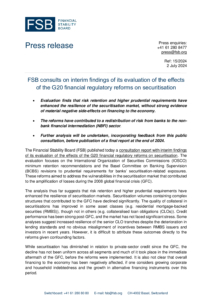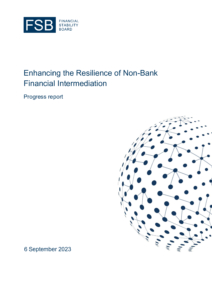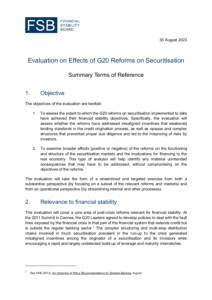Summary of document history
Risk retention reforms and higher bank prudential requirements aimed to address the vulnerabilities in the securitisation market that contributed to the amplification of losses during the 2008 global financial crisis.
The complex structuring and multi-step distribution chains involved in certain securitisation structures in the run-up to the 2008 global financial crisis (GFC) generated misaligned incentives between the originator of a securitisation and its investors. This led to weakened lending standards, while amplifying a rapid and largely undetected build-up of leverage and maturity mismatches. A number of regulatory reforms have since been introduced to improve transparency, address conflicts of interest, strengthen the regulatory capital treatment for banks’ securitisation exposures by improving risk sensitivity and reducing cliff effects, and align incentives associated with securitisation.
The objectives of the evaluation are twofold:
- to assess the extent to which risk retention and higher bank prudential requirements implemented to date have achieved their financial stability objectives and
- to examine broader effects (positive or negative) of these reforms on the functioning and structure of the securitisation markets and on the financing of the real economy.
To achieve this, the evaluation examines the mechanisms through which these reforms are expected to operate and associated metrics to assess securitisation market resilience.
The analysis thus far suggests that the reforms have contributed to the resilience of the securitisation market without strong evidence of material negative side-effects on financing to the economy, though the findings are preliminary and need to be confirmed by additional work. Looking ahead, the FSB will continue its analysis of the effects of these reforms and expects to publish the final report at the end of 2024.
The FSB invites comments on this consultation report and the questions set out below. Responses should be submitted via this secure online form by 2 September 2024.
Questions for consultation
Overall
- Preliminary findings: Does the report draw the appropriate inferences about the extent to which the securitisation reforms have achieved their objectives? Is there other evidence on the effects of the reforms to complement the preliminary findings of the report?
- Analytical approach: Are the descriptive analyses used to evaluate the effects of the securitisation reforms appropriate? Are there other such analyses to consider? What types of empirical analysis based on available data could inform the evaluation?
Overview of securitisation markets
- Trends: Are the securitisation market trends presented in this report adequate given the scope of the evaluation? Are there other important trends that should be included and, if so, what additional data sources could be used for this purpose?
Securitisation reforms
- Relevant reforms: Does the report appropriately describe the key aspects of the design and jurisdictional implementation of the BCBS and IOSCO reforms for analysing their impact on securitisation markets? Are there other important aspects of these reforms that should be considered for inclusion?
- Other reforms: Does the report accurately identify other G20 and domestic financial reforms that are most relevant for securitisation markets? Are there other reforms that should be considered in terms of their impact on market participants?
- Conceptual framework: Does the report adequately explain the objectives, transmission channels and expected outcomes of the securitisation reforms? What other metrics to assess the impact of the reforms should be considered?
Effectiveness of the securitisation reforms
- Resilience metrics for the CLO market: Does the report accurately describe the evolution of resilience indicators for the CLO market? To what extent can the evolution of these indicators be attributed to the reforms?
- Risk retention in CLOs: Does the report accurately describe risk retention practices in the CLO market before and after the reforms? What additional analysis could be included to assess the effectiveness of risk retention in CLOs across FSB jurisdictions, including on how financing of risk retention deals by third party investors impacts effectiveness?
- Resilience metrics for the non-agency RMBS market: Does the report accurately describe the evolution of resilience indicators for the RMBS market? To what extent can the evolution of these indicators be attributed to the reforms?
- Risk retention in RMBS: Does the report accurately describe risk retention practices in the RMBS market before and after the reforms? What additional analyses could be included to assess the effectiveness of risk retention in RMBS across FSB jurisdictions?
- Effectiveness of BCBS securitisation reforms: Does the report accurately describe the changes in bank behaviour following the implementation of the BCBS securitisation framework reforms? To what extent can the effects of these reforms be disentangled from the broader Basel III framework, other reforms and confounding factors?
- Simple, transparent and comparable (STC) securitisations: Does the report accurately describe the impact of the introduction of the STC framework on the securitisation market? To what extent has the reform met its objectives?
Broader effects of the reforms
- Effects on financing the economy: Does the report accurately describe the main effects of the reforms on financing the economy? Is there additional analysis that could be undertaken to estimate the benefits and costs of these reforms and to assess their impact on securitisation as a financing tool?
- Effects on financial system structure and resilience: Does the report accurately describe the extent to which there has been a redistribution of risk from the banking to the non-bank financial intermediation sector? What role did the reforms play in this process and what are the main benefits and risks from a system-wide perspective? How have the reforms impacted the demand and supply of liquidity in securitisation markets?
Additional considerations
Other issues: Are there any other issues or relevant factors that should be considered as part of the evaluation?
Responses should be submitted via this secure online form by 2 September 2024. For questions, please contact the FSB ([email protected]).


